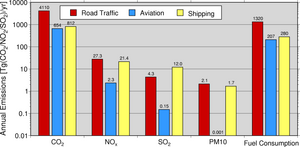|
 Figure
1: Transport-related annual emissions
of CO2, NOx, SO2 and PM10 and the fuel
consumption in Tg (1 Tg = 10^12 g = Mt) estimated for the year 2000. Modified
from Figure
3 of Eyring et al. (2005),
Emissions from international shipping: 1. The last 50 years, J.
Geophys. Res., 110, D17305, doi:10.1029/2004JD005619 (Copyright 2005 by
the
American Geophysical Union). Figure
1: Transport-related annual emissions
of CO2, NOx, SO2 and PM10 and the fuel
consumption in Tg (1 Tg = 10^12 g = Mt) estimated for the year 2000. Modified
from Figure
3 of Eyring et al. (2005),
Emissions from international shipping: 1. The last 50 years, J.
Geophys. Res., 110, D17305, doi:10.1029/2004JD005619 (Copyright 2005 by
the
American Geophysical Union). |
Regulating
transport emissions requires comprehensive knowledge of the present day
fuel consumption and emissions, their potential future
evolutions,
and mitigation options. Recent studies by the Institute of Atmospheric
Physics of the German Aerospace Center
DLR and
by the
College
of Marine and Earth Studies of the University
of Delaware in the United States of America (USA)
reveal
converging estimates of current ship emissions and suggest that
shipping
emitted around 800 Tg CO2 and contributed around 2.7% to all
anthropogenic CO2 emissions in 2000 [1,2] (1 Tg = 1012
g
= 1 million metric tons = 1 Mt). Given uncertainties in all emission
inventories, these figures should be considered our best estimates
within a
bounded range of 600 to 900 Tg of CO2 per year [2]. Our
research
concludes that CO2 emissions from shipping are of the same
order as
published CO2 estimates for aviation.
For comparison,
aviation and road transport contributed around 2.2% and 14%,
respectively. Other
comparisons suggest that shipping accounts for around 15% of all global
anthropogenic nitrogen oxides (NOx) emissions and for around
8% of sulfur dioxide (SO2) emissions [1,2]. The relatively
high contribution results because most
marine
engines operate at high temperatures and pressures without effective NOx
emission reduction technologies and because of high average sulfur content
(2.4%-2.7%) in marine
fuels.
Recent studies from DLR have shown that
fuel consumption from ocean-going ships has increased by a factor of
4.3 from
1950 to 2000, reaching around 280 Tg today [1]. And importantly, future
scenarios demonstrate that significant reductions are needed to offset
increased emissions due to growth in seaborne trade and cargo energy
intensity
[3]. If no aggressive emission reduction strategies are introduced, CO2
and SO2 emissions from ships could double present-day values
by 2050,
and NOx emissions could exceed present-day global road
transport.
Global
comparisons of emission totals from different transport modes describe
however only part of the picture. For
example,
the related passenger and freight transported volumes will need to be
considered in addition. Also, the distribution of shipping activity
follows major trade routes, such
that ship
emissions near coastal areas affect regional air quality, environment,
and
public health. Evaluating these impacts requires atmospheric research
that
helps developing appropriate reduction strategies and allows the
industry to
incorporate, with greater confidence, environmental considerations into
their operations.
Our inventories and further planned research contribute to that ongoing
science-technology-policy
dialogue.
References:
[1]
Eyring, V., H.W. Köhler, J. van Aardenne, and A. Lauer
(2005a), Emissions
from international shipping: 1. The last 50 years, J.
Geophys. Res., 110, D17305, doi:10.1029/2004JD005619.
[2] Corbett, J.J., and H.W. Köhler (2003), Updated
emissions from ocean
shipping, J. Geophys. Res., 108,
doi:10.1029/2003JD003751.
[3] Eyring,
V., H. W. Köhler, A. Lauer, and B. Lemper (2005b), Emissions
from international shipping: 2. Impact of future technologies
on
scenarios until 2050, J. Geophys. Res., 110, D17306,
doi:10.1029/2004JD005620.
Other Press Information:
- Reconciling past and future trends in ship work,
energy, and emissions, more...
- Eyring, V., J. J. Corbett, D. S. Lee, J. J.
Winebrake, Brief summary of the impact of ship emissions on
atmospheric composition, climate, and human health; Health and
Environment Sub-Group of the International Maritime Organization:
London, UK, 6 November 2007.
- Aerosols from ocean shipping cause a significant
negative climate forcings, more...
|











